
views
Climbing without Gear

Choose a small tree. The first coconut tree you climb should be small, ideally low enough that you can grab onto the base of the fronds while standing on the ground. At minimum, pick a tree that you can wrap your arms around. A tree leaning at an angle will also be easier to climb.
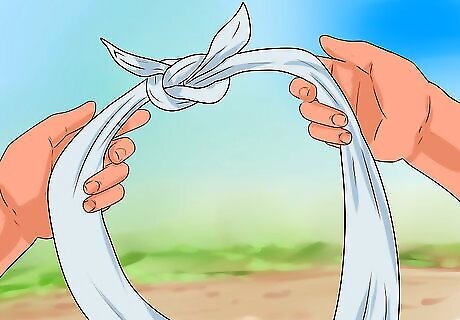
Make a foot strap out of strong cloth. Choose a strong material, such as coir, jute, or burlap, or a coil of strong, thin rope. Tie each end of the strip into a loop, just big enough to wrap around the soles of your feet. When complete, you should be able to flatten the strip against the coconut palm, with your feet on opposite sides of the trunk. While you can climb a tree without any gear at all, this loop will make the task much easier.
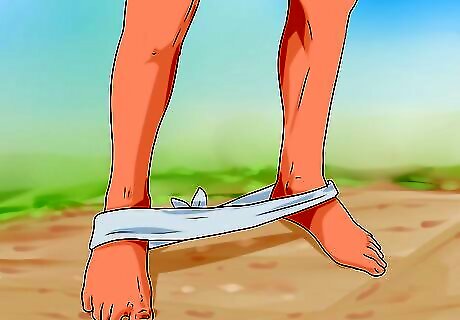
Fit the loop around your feet. Place each foot through a loop on either side of the strap, and tighten securely with a strong knot. Now, when the base of your feet grip the sides of the tree, the cloth will press against the tree as well. This helps keep your feet stable, and gives you more leverage to push yourself up the tree. Take off your shoes and socks before doing this. Climbing can hurt if you're not used to going barefoot, but your skin will toughen up with practice. If you really want shoes, try a special pair of climbing shoes with plenty of traction and flexible soles.

Grip the tree between your hands. Press one hand against the trunk in front of you, at chest level. Press the other hand on the opposite side of the tree. Your arms must be strong enough to hold your weight, so you are leaning into the tree instead of dangling away from it. Some people feel more secure placing both hands at the back of the tree. If you do this, place your hands near the sides, where the trunk is curving round to the back. Your hands need to be at least partly opposite each other, so you can squeeze the trunk. For trees too thick to wrap your arms around, find a second strip of strong cloth, leather, or rubber. Loop it around the trunk, and either grip it in your hands or tie yourself securely inside it. Start on a small tree before trying this.
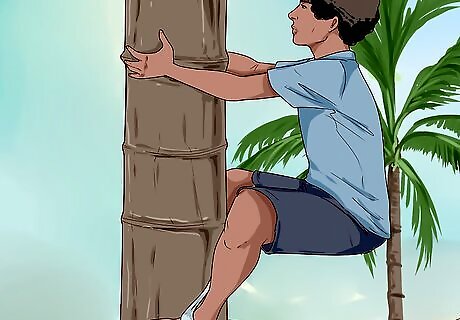
Place your feet against the sides of the tree. Hop onto the base of the tree, gripping it with your legs. Turn your feet inward, so the undersides of your feet press against the left and right sides of the trunk. Your legs will be bent and splayed outward, like a frog's. Make sure the loop around your feet is stretched taut against the tree. Grip the tree with your thighs as well, if you are flexible enough to do so.
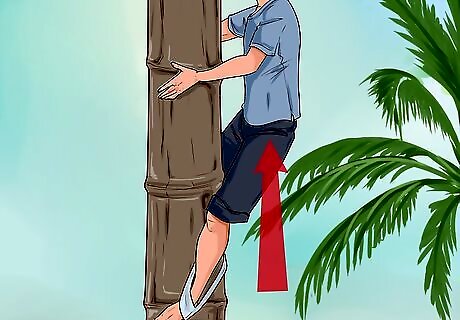
Push yourself up with your feet. Extend your legs without moving your feet or hands. This will bring you up straight, a little higher than before.
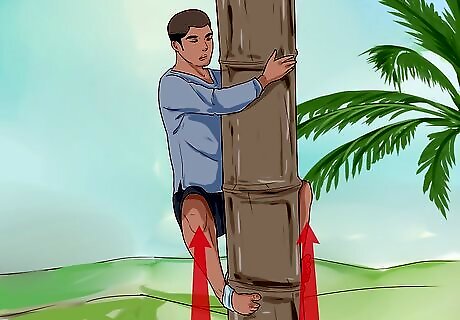
Bring your feet up. Quickly bring both feet up at the same time, gripping a spot higher up the tree. To keep yourself stable, press hard with both hands. If your arms are strong, you can lift your feet completely off the trunk and position them again at a higher point. Otherwise, slide your feet up the side of the trunk, or push them up one at a time in small steps. This requires less muscle, but can be painful on soft feet. Keep your foot on opposite sides of the tree, so the loop doesn't fall off your feet. This is the most difficult part. Practice going up and down at the lowest levels of the tree, until you are confident that you have a firm grip.
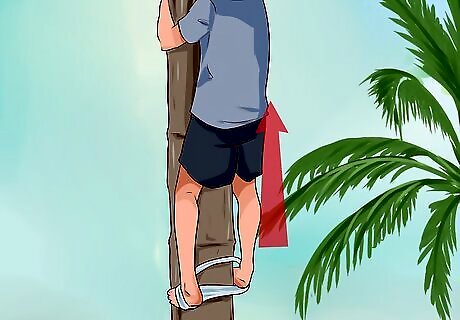
Repeat. Now you're back in your starting position. Extend your legs to lift yourself higher, and rest here if you need to. When you're ready, bring your feet up another step, squeezing the tree between your hands. Practice this near the base of the tree before aiming to go higher. Don't climb high enough to risk serious injury until you have had some practice. You should have enough arm strength and leg strength to climb without feeling tired or shaky, and enough flexibility to easily grip the tree between your feet.
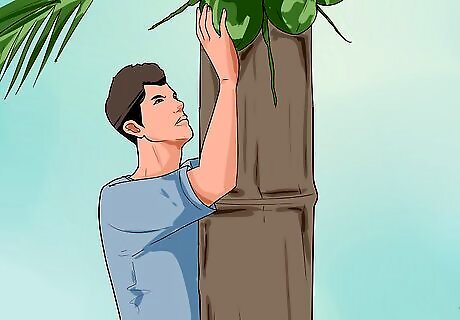
Pick the coconuts. Once you are ready to climb to the top, pick a coconut by twisting it repeatedly until the stem breaks. Drop it on the ground, making sure there is no one nearby. Only pick coconuts easily within arm's reach, and never lean out away from the tree. The fronds on the second or third level up are usually strong enough to hold onto, or even sit on. Do not grab the fronds on the lowest level, which are often weak. If you are skilled at using a machete, you can chop off coconuts with the blade. Tie the machete to a rope at your belt, so it dangles well below your feet as you climb.
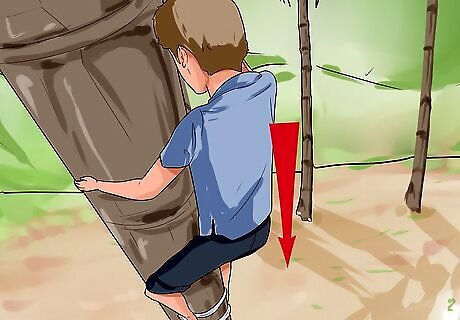
Descend. You can descend in steps just as you descended. Most people just move their hands lower one by one, while their feet slide down the palm. This can scrape or cut soft feet, but once you've toughened up this is the fastest way to get down.
Climbing with Gear
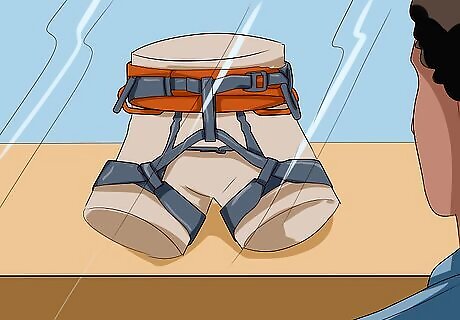
Find a comfortable harness. The harness should be wide and padded, not a thin rock-climbing harness. Rope belts are used in some parts of the world, but these won't secure you nearly as well. Read the instructions below first, to decide on a method of climbing the tree. You might be able to buy all your gear as part of a kit, to save money.
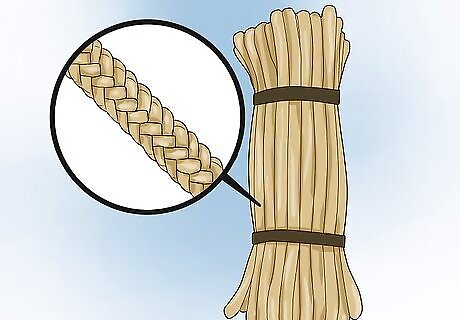
Choose your rope. Find a strong rope or webbing, with no significant stretch (or labeled "static"). The rope should be braided, not twisted, so it won't send you spinning, although this is a little less important since you won't be dangling from the rope. Tree-climbing or "arborist" rope is the best choice.
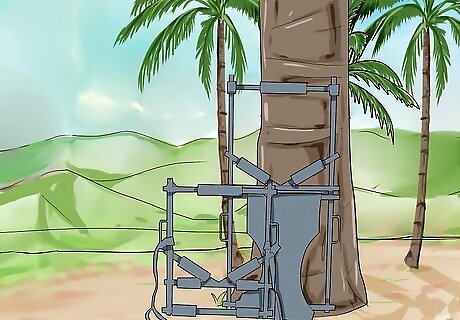
Use a palm climbing machine. These devices attach to the tree and provide loops for your hands and feet. To ascend, all you need to do is alternate lifting your hands and feet, and the machine will do most of the work for you. It is still a good idea to secure yourself to the tree trunk using a length of rope and a harness, using the equipment described above. There are several designs of climbing machines. Refer to the instructions specific to your model before you try to ascend.
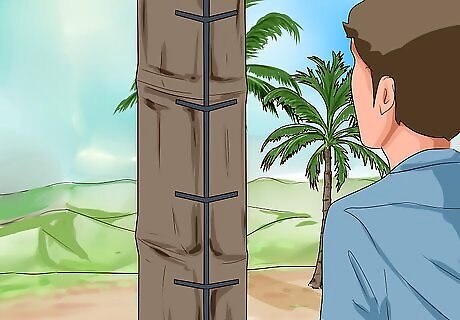
Try a stick ladder. This is an easy, safe way to climb straight palm trees shorter than the stick ladder. Look for this equipment in hunting goods stores, since the ladders are often used to make hunting platforms. Follow these instructions to stay safe during your ascent: Assemble your stick ladder and lean it against the tree. Push it into the ground and clip it to a strap or length of rope tied around the tree. Loop another strap or rope around the tree, and clip both ends onto your harness. Adjust until the strap is taut when you stand on the ladder. Climb the ladder, periodically tying additional straps around the tree and onto the rungs.
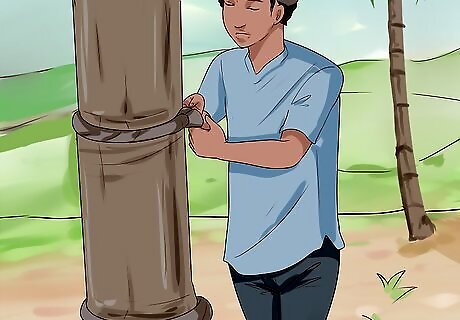
Climb with rope loops. It is possible to make climbing easier and more secure even if you don't have any special equipment. Because your knots must be precise and high-quality, it's best to learn directly from an experienced professional. Here is the basic idea: Wrap rope around the tree, and fasten both ends to your harness. With another length of rope, make a loop for one of your feet to stand in. Attach the other end of this loop to the trunk by looping it around and tying a prusik knot. Repeat with a second loop for your other foot, and a third loop for your hands. To climb the tree, lift one foot while pulling its rope higher with your hand. When you let go and put weight on that foot, the knot should hold the rope steady again. Alternate lifting each loop. Stay near the ground for your first several sessions, until you are confident you have the technique down and your knots are steady.

















Comments
0 comment